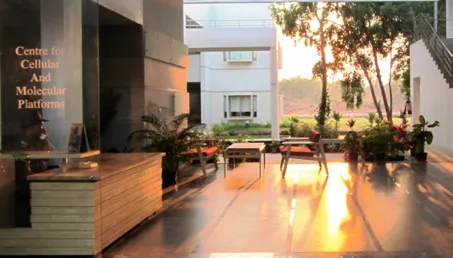Why India 4.0 needs stronger engines of bio-innovation: A C-CAMP perspective
Unless bio-innovation hubs with enhanced capabilities are given priority, the scientific and tech development of the country might encounter a huge speed breaker. Enabling cutting edge life sciences and research which centres like C-CAMP are known for is key to accomplishing this scale.
A nation’s investment in scientific and technological development is a critical determinant of its socio-economic growth. Major economies like the US, China, Japan and Germany are testament to this. In this regard, India has been on a phenomenal trajectory since liberalisation in 1991 – we are at $2.7 trillion GDP today, and have an ambition economic vision of $5 trillion GDP by 2025 and $10 trillion by 2030. Without a strong innovation anchor, meeting New India’s economic targets might prove difficult. It is imperative we build world-class innovation hubs that serve as growth drivers for socio-economic growth.

In India, entrepreneurs and innovators productising new research are driving the next wave of innovation. The role of innovation hubs that amalgamate entrepreneurship, industry, capital and research has never been more essential. Large economies all have exceptional ecosystems. Prime examples are the San Francisco Bay Area and Boston ecosystems in the US, and China’s National High-Tech Development Zones. They are an amalgamation of highly specialised talent, research from top-tier universities, large pools of investable capital, access to market leaders, an incentive system for entrepreneurs, and a promising market to capture. India must actively build and nurture its own hubs to prime such ecosystems for itself.
During the 2019 elections, the NDA announced that it endeavoured to facilitate the establishment of 50,000 new startups by 2024, create 100 innovation zones, and 500 incubator/accelerators. The government can jumpstart this by accelerating its well-established innovation hubs and enhancing their capabilities. In the field of life sciences, the Department of Biotechnology (DBT) – BIRAC has already set up the first hubs to support early-stage bio-entrepreneurship. One such hub which has validated this approach is the Centre for Cellular and Molecular Platforms (C-CAMP) in Bengaluru.

Bengaluru: Cornerstone for India’s bio-innovation
While Delhi, Mumbai, Hyderabad, and other cities are home to some great innovation, Bengaluru is India’s indisputable technological giant. Accelerated by the IT boom in the 90s, Bengaluru attracts India’s best technical talent in many spheres including biotechnology and life sciences. Global innovation is increasingly inter-disciplinary, and Bengaluru - with India’s premier labs and innovation drivers - is developing into the next Silicon Valley.
The Economic Survey of Karnataka 2018-19 estimates Karnataka houses 60 percent of India’s biotech companies – small, medium and large – and employs nearly 54 percent of the country’s biotech workforce. Most of this is centred in Bengaluru; making it the clear frontrunner in bio-innovation in India.
Two key elements characterise bio-innovation in Bengaluru. One, the presence of large pharmaceutical and bio-manufacturing giants like Biocon, Jubilant, Anthem, etc. Second, the city is home to a cluster of premier research institutions like NCBS, InStem, IISc, IBAB, JNCASR, and others. This superimposition of industry and research in Bengaluru’s biotech ecosystem is unique in India and has been decades in the making.
We know from studying global ecosystems like the San Francisco Bay Area that it is crucial to converge research, start-ups and industry. As with other deep science fields, bio-innovation necessitates in-depth research, the requirement of specialised and often expensive equipment, and long runways to bear fruit. Testing and validation cycles run into years, as do intellectual property filings and regulatory clearances. To support this, the role of all-in-one innovation hubs like C-CAMP is essential.

Centre for Cellular and Molecular Platforms, Bengaluru, India
C-CAMP: National anchor for bio-innovation
Founded in 2009, C-CAMP is deeply embedded in the cutting-edge, world-class scientific environment of Bengaluru’s bio-innovation ecosystem. Designed and helmed by scientists, C-CAMP’s DNA is rooted in scientific rigour and attuned to the needs of scientist-entrepreneurs. It has meticulously built a platform for bio-innovators to incubate, conduct research and launch products. C-CAMP is intimately connected with 1,000+ startups across India.
C-CAMP serves as the deployment vehicle of new policy initiatives such as Biotechnology Ignition Grant and Atal Innovation Mission with central government ministries like DBT and NITI-Aayog. C-CAMP also works with GoK to launch initiatives like K-Tech and Agri-innovation CoE. The innovation hub runs India’s largest ideas platform – the National Bio Entrepreneurship Competition (NBEC). Though physically located in Bengaluru, C-CAMP is a national catalyst for bio-innovation.
Many of India's uber-successful life sciences startups – Bugworks, Sea6 Energy, Theramyt, Pandorum, Eyestem, Coeo, Module, String Bio, Aten Porous, and others – have emerged from this innovation ecosystem. They are expanding rapidly into domestic and global markets. Now that we have a winning strategy that supports early innovation, how do we enable these winners to scale up? Further, what is the best investment we can make today that will continue generating world-class innovation out of India in the decades to come?
Expansion is key
Centres like C-CAMP have already amassed state-of-the-art research facilities, technical know-how, and expertise under one roof. Several government ministries have worked hard with them for a decade to perfect this strategy. The time is ripe for expansion.
Critical mass of specialised talent: India must not let down its top innovation talent for want of capacity. One of the most significant resources for deep science innovation is a critical mass of intelligent scientists with converging skill sets. This is the prime driver of Silicon Valley and other global ecosystems. At C-CAMP as well, incubates find that their neighbours in the C-CAMP-NCBS-InStem ecosystem are valuable resources. By expanding the capacity of hubs like C-CAMP, more scientist-entrepreneurs can join. Enabling such critical mass build-ups will help India create science powerhouses.
Academic-entrepreneurs: Innovation hubs sit in a critical junction to support academicians, making a move into productization. C-CAMP already supports several from InStem, IISc, and other institutions due to its unique position. Today, many promising researchers go abroad in search of well-facilitated ecosystems. Instead, they can be incentivised to productise their research at world-class innovation hubs in India itself.
Scale-up space for startups: As successful incubates scale into production and high-volume manufacturing, they need to set up production plants, testing and quality labs, sophisticated waste disposal systems, and more. Crucially, they must remain connected to the scientific backbone and retain proximity to the research-academia environment that hubs like C-CAMP pioneer to innovate and improve their products and services continuously. Scale-up space around the centres will enable proven winners to grow faster.
Global partnerships: A key strategy of innovation hubs has been global partnerships. For example, C-CAMP partners with top life sciences ecosystems like QB3 in the SF Bay Area, Roslin Institute in Edinburgh, Tokyo’s BNV, AMR Global in Netherlands, and CARB-X (the global consortium combating antimicrobial resistance). C-CAMP is often the first stop of international delegations from the US FDA and HHS, and European ministries like the Netherlands’ health minister because of its global reputation in the space. Innovation hubs serve as valuable two-way conduits for global innovators to collaborate with Indians and vice-versa, opening up access to new markets and strategies.
Focus on quality as well as quantity: With all the advantages existing hubs bring to the table, policymakers must approach investment in innovation hubs at two levels:
- Building the proposed 500 new hubs in phases, based on assessment and requirement.
- Deepening the capacity of well-established centres with proven track-record and potential to be global-impact hubs.
The latter can quickly position India amongst the top five destinations for life sciences (and other) innovation.
Undoubtedly, innovation is essential to economic growth. We already see the tremendous impact startups have had on our economy. With India’s sights set on reaching $5 trillion by 2025 and $10 trillion by 2030, developing an innovation ecosystem that can generate multiple multi-million dollar businesses is a no-brainer.
(Edited by Suruchi Kapur- Gomes)
(Disclaimer: The views and opinions expressed in this article are those of the author and do not necessarily reflect the views of YourStory.)








